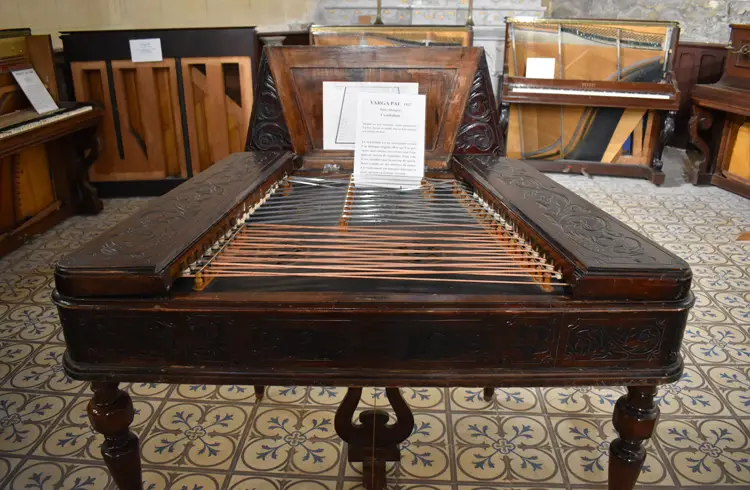Romanian accordion music has its own styles and characteristics but is often called “Balkan music” which actually includes the music of many countries of the Balkan peninsula (Albania, Bosnia and Herzegovina, Bulgaria, Cyprus, Greece, Kosovo, Montenegro, North Macedonia, Romania, Serbia and Turkey). In this article, I will talk about a traditional style of Romanian music from southern Romania called “lăutărească”.
Romania is a country between multiple areas of cultural influence, you could say on the border between several worlds. On one side, there is the Balkan peninsula, with its tradition and culture. On the other side, there is the eastern block of countries that were under Soviet influence. Then there is the modern-day worldwide connectivity brought by the Internet and by the possibility to travel easily around the globe. All these play crucial factors in the way musical tendencies are developing in the area.
What instruments are used in traditional Romanian music?
A traditional Romanian ensemble is called “Taraf“: these ensembles usually consist of violin, accordion, double bass and cimbalom. There is no rule for this, and not seldomly other instruments may join, such as the clarinet, brass instruments or even whistles or other woodwinds.
The accordion is quite a common and wide-spread instrument in Romania, and the Romanian accordionists sure know how to take advantage of its extended capabilities, going even as far as filling in for other instruments in an ensemble, as it can easily take over most of their function.
The cimbalom

Author: Tylwyth Eldar
This file is licensed under the Creative Commons Attribution-Share Alike 4.0 International license.
You may have noticed that I haven’t brought up any instruments that are strictly percussive. The double bass of course will keep the pulse and the basic underlying harmonic structure, while the cimbalom, plays a role similar to a drum kit.
The rhythmic function of the cimbalom is very important, as, unlike the double bass, it also accounts for various temporal subdivisions of the music, which can give the song a certain characteristic, and without which the song would have none of that authentic feeling.
How to accompany Balkan music with the accordion?
Right hand
The accordion technique for accompaniment has been adapted so that it can take the place of a cimbalom (although the sound itself is, of course, somewhat less percussive), by alternating sets of chords and single notes on the right hand. The single notes are most often taken care of by the thumb of the right hand and it is usually called “ciocănel“, which translates to “little hammer” because of its rhythmic function. You may have songs of various speeds, which will influence the style of the accompaniment. A very simplified version of this technique consists in accenting upbeats with chords. This is usually the role played by the viola or fiddle, commonly referred to as “braci“.
Left hand
The left hand will usually follow the right-hand accompaniment pattern in a simplified way accenting upbeats with chords. If the accordion player is really versatile, he can use them to replace the walking bass lines played normally by the double bass, lines that are quite intricate and often shifting, even if the key doesn’t change a lot, because this type of music usually relies very heavily on ever-changing chord voicings, so as to have a sense of perpetual motion. Which brings us to some thoughts on harmony.
What scales are used in Romanian music?
Major scale
One of the very common scales that “lăutărească” uses is the Romanian Major scale which is a lydian dominant flat 2 (or flat 9) and it goes like this: C – Db – E – F# – G – A – Bb – B

The first thing you may notice is that you have a set of 8 notes, instead of the more conventional 7 note set. This scale has all the notes of a diminished chord, which brings a plus of instability and a predisposition to motion. The last 3 notes are just a chromatic sequence because chromatic passages are very often used.
However, this scale is not very strict, and you will often find songs that occasionally venture outside of it. This is what is most often going to be used instead of the regular major scale.
Minor scale
When it comes to minor keys, the most common scale is the Romanian Minor scale which is an altered Dorian scale (4th mode of the harmonic minor scale with a tritone and altered 6th and 7th). For example C – D – Eb – F# – G – A – Bb – C.

It still does contain a diminished chord starting from the tonic, which allows for extended harmonies and ease of transposition between keys.
Chromatic scale
The chromatic scale is often used in all Balkan music styles. It’s usually played with a very peculiar fingering very different from the classic one:




What are the most common rhythm styles in Romanian accordion music?
We can divide the Romanian accordion music into two categories: “sârbe” & “hore”.
“Sârba” (which literally means “Serbian”) is a style that heavily relies on triplets and on the swing effect you get by playing only the first and the third triplet in a set, which is sometimes very similar to some traditional rhythms in 6/8.
“Horă“, means a traditional circle dance that can also be found in other Balkan cultures, and differentiates itself from the former because the rhythm has a certain swing but it’s “straight” like a simple 2/4.
In Romanian music, uneven time signatures are quite common, one of them is the 7/8. This rhythm is called “Geampara“, and it originates in the southeastern part of Romania:
A less known style is the “Cadâneasca“, which is in 5/8 or in 9/8:
How to play uneven time signature
All these uneven time signatures are not perceived as some complex, but rather naturally simplified by being played in “short notes” and “long notes“. For example, if you take a 7/8 song, you can subdivide it in one of the following two ways:
- long + long + long + short (which is: 4th note + 4th note + 4th note + 8th note)

or
- short + short + long (which is 4th note + 4th note + dotted 4th note)

In the case of a 9/8 times signature, you can see it as:
- 4th note + 4th note + 4th note + dotted 4th note.

In the same manner, you can also subdivide any other uneven time signature.
This is what you would most probably accent with the left hand on basses and with the right hand you can run through all the sixteenth notes or make various combinations and phrases starting from these subdivisions.
Ornaments in Balkan music
Another aspect of great importance is the presence of ornaments in Balkan and Romanian accordion music. Players don’t shy away from using them. Most often you will find trills, mordents and appoggiaturas. The latter can take a multitude of forms, as you don’t necessarily have to use the semitones near to the note, but you can go as high as you want, each quick interval having a unique flavor.
Thirds, fifths and even sevenths are fairly common. They are also used to separate two repeating notes, as one would do on a woodwind instrument in this kind of music, as it confers it a more authentic sound than clean notes that are repeated. You can almost associate it with some sort of cry or lament. However, if the song gets really fast, of course, you cannot fit in all those ornaments, so when you have repeated notes, you just play them with a succession of alternate fingers.
Video lessons and tutorials about Romanian and Balkan accordion music
A good resource that I recommend is Paul Stanga‘s YouTube channel: he is a Romanian accordionist who also regularly uploads some lessons with tips and tricks for this kind of music. His lessons are in Romanian, but you can still get the main ideas if you follow the practical side.
Also, check Vitalie Vataman on YouTube, on his channel you can find some tutorials and lessons about this beautiful music style. For more general Balkan music tutorial for accordion, you can watch these videos on the Liberty Bellows channel.
Conclusion
This article only scratches the surface of this music. It’s beautiful and very difficult to play it properly. There isn’t much documentation online about it, nor are there proper music schools that teach this, so to get to know the secrets of this craft well, you need to take up lessons with someone who plays this kind of music for a living.
Usually, musicians who play lăutărească usually learn and play by ear, giving them freedom for improvisation and some sort of eagerness to experiment new ways of expression without the fear of breaking some previously imposed rules. Naturally, there are musicians who also take up academic musical education further in life, but most of them don’t. So it’s an entirely different system on how to approach and understand music in general, nevertheless beautiful and intriguing.
Author: Andrei Oltean
Editor: Giovanni Lucifero

Interesting article, Professor Giovanni.
Is there a chance you could consider doing an article about waltz music? That would be also very interesting to read.
Thank you for your suggestion. I would be happy to consider writing an article about waltz music. It is a fascinating and rich genre that deserves more attention. As for your question, I have indeed written an article about Sous le ciel de Paris. Let me know if you have any further questions or requests for articles. I am always open to new topics and ideas.